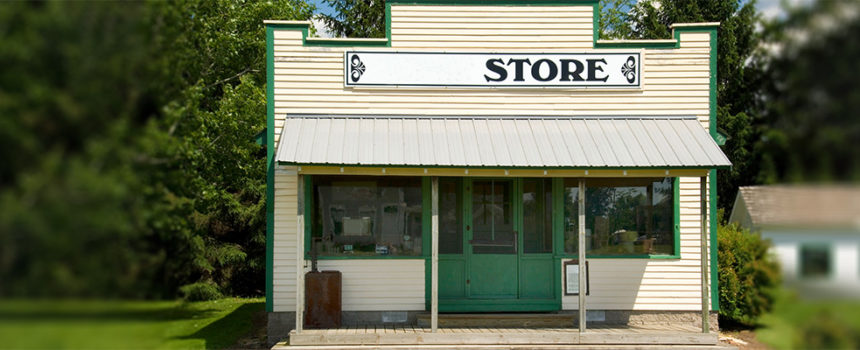“The more things change, the more they remain the same.”
—Jean-Baptiste Alphonse Karr
Our grandparents often told us that, back in their day, they knew how to get things done, and that today, with all our complexity and complication, we’re seriously lost.
Well that might be true…but in the case of technology, sales automation will be bringing us back to something very beloved in our collective memory: the town General Store.
Believe it or not, it all falls under the topic of data automation.
Improvements Only the Beginning
We’ve seen many improvements in recent years with regard to data. An example is the business card scanner which we ourselves at Pipeliner have added to our mobile CRM solution. Reading the card is a simple scan. From that scan, contact fields can be auto-populated within Pipeliner. In the old days, you might have attended a trade show and come home with dozens of business cards that you’d then have to manually enter into your contact database. Very fortunately, those days are well behind us.
But scanning business cards is only the beginning. The data on that card might not be totally correct due to printer errors. Or, the person or business might have moved. If you wait a bit to contact them, the person might have even changed companies. You’re lucky if the person hasn’t changed phone numbers, too.
Unprecedented Data Access
Fortunately, though, we have unprecedented data access today. Data providing services, to which you can subscribe, grab data from other databases and off the internet so that your database can be automatically updated.
Previously you had to log into such a provider and purchase data. This was before the advent of APIs (discussed in our last article). Now everything is done through an API. With a technology called Webhooks, data can be pulled and pushed. The kind of tasks that were in the last few years long and complex are becoming incredibly fast and easy.
Data is not only grabbed from the internet, but that data can be updated, enriched, deduplicated and merged.
Importance of Data Automation
Marketing costs can eat into a company’s budget. When contact details are incorrect, that means the email you send will bounce, which is a waste of time, effort, and money. It is even more so when you’re sending physical items such as letters or packages.
With data, we do have to make one fundamental assumption: that the person named is indeed the person. Beyond that, it shouldn’t matter where that person lives or how often they move. The only thing that matters is, how can we keep that data current—mail, email, and phone—and use it correctly and efficiently?
Today that’s the point of data automation—to keep that data current.
The Near Future
I believe that a next step, coming in the near future, will be data history. That means not just the current data, but the evolution that data has gone through. Where has the person worked before? Where have they lived? What kind of social media interaction have they had?
I also believe that connections and relationships will also be available. It’s not just about the person you have on file, but their connections—who they are and how they are related. This isn’t simply contact connections, such as those shown on LinkedIn or Facebook, for these aren’t actual relationships. For example, I have close to 8,000 contacts on LinkedIn, but am I really connected to those people? No. But in the future, someone will be able to find out who is actually connected to me, who has interacted with me.
Such details mean that the salesperson can customize a product or service for a prospect, and hit it right on the mark.
We’re definitely on the way there. We can now keep the information up-to-date and enrich it. Next will be history and connections as well.
Privacy
Of course, along with such innovations, privacy is an enormous issue, which we’ll be taking up in a separate article. The General Data Protection Regulation—GDPR—is already in place in Europe, and will soon roll out worldwide. As businesspeople, we certainly want access to as much data as possible, but at the same time as citizens, we certainly don’t want our privacy violated.
Customer Insight and the General Store
Going back to the beginning of our article, it seems that in very appropriate ways, we’re going back to the General Store of American history.
What are we looking for with all this automation? Customer insight. And nobody had more customer insight than the proprietor of the General Store.
That proprietor always knew their customer. Not only the customer, but the customer’s family—children, spouses, and relations. They would greet a customer with, “Hey, Mary, how are you? How is John doing? How are the kids? By the way, I’ve reserved a couple of bottles of bluing that I knew you needed, and I kept aside a couple sticks of that penny candy that I know your kids love.”
That proprietor had a 360-degree view of their customers. They knew everything about them. What is amazing is that we now depend on databases to keep track of customer data—but everything that proprietor knew was right in their head.
Where We’re Going
This is where we’re headed, with data automation. When someone contacts you personally and has insights into your issues and preferences, how much difference does it make from someone just cold-calling you and giving you a pitch for a product or service you may or probably don’t need?
Our product Pipeliner is already quite flexible with our business card scanner, data enrichment, data migration, data cleansing, duplication checker and relationship mapping.
In 2 or 3 years, who knows? We may very well have the Pipeliner General Store.






















Comments